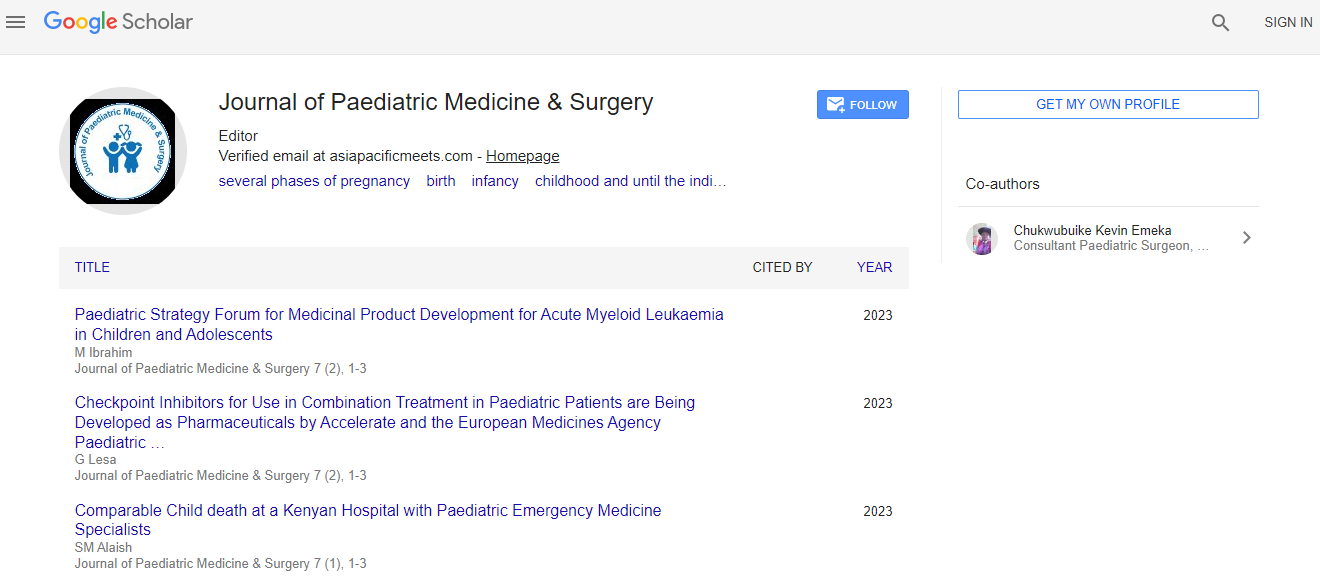Pediatric Surgery and Neonatology 2018: The evidence-based C-section and the risks involved in the exaggeration of its use - Michael Stark - New European Surgical Academy
*Corresponding Author:
Copyright: © 2018 . This is an open-access article distributed under the terms of the Creative Commons Attribution License, which permits unrestricted use, distribution, and reproduction in any medium, provided the original author and source are credited.
Abstract
At the point when doctors performed cesarean areas in the nineteenth century, they usually looked for understanding from all present before continuing. Interestingly, after the presentation of electronic fetal checking in the late 1960s, obstetricians got authorization for a cesarean by offering a decision that guaranteed assent-conceive an offspring by cesarean or conceive an offspring vaginally to a harmed or dead child.
As most stomach activities have endoscopic other options, cesarean segment will remain the main stomach activity later on. Hence it is of most extreme significance to continually assess the various strides for their need and for their ideal method of execution. The altered Joel-Cohen strategy brings about a shorter entry point to conveyance time, lower pace of febrile dreariness contrasted with the conventional P-fannenstiel cut. Opening peritoneum utilizing bi-advanced extending as opposed to sharp instruments end up being more secure, and exteriorization of the uterus makes sewing simpler and keeps away from pointless dying. Stitching the uterus with one layer just outcomes in more grounded scars and diminished torment. Leaving both peritoneum layers open diminishes attachments. The belt being stitched constantly with first bunch underneath the sash forestalls disturbance in the sub-cutis and by a right-gave specialist, from the privilege to one side, end up being ergonomic. Since the presentation of this adjusted and streamlined technique, it has been assessed in many companion looked into distributions from changed nations. No matter what, all demonstrated different favorable circumstances of this strategy: shorter activity time, shorter hospitalization, faster mobilization, less blood misfortune, lower pace of febrile dismalness, lower costs, and less requirement for painkillers. Just 10 instruments and three stitches are required, which rearranges the remaining task at hand of medical attendants. So as to normalize this activity, it is imperative to utilize continually similar needles and instruments. Huge needle is essential for the uterus, as less advances are done and hence less outside body response. This activity is suggested as all inclusive routine technique for cesarean segment and its standards ought to apply to every careful control. Tragically, the pace of cesarean area is rising continually around the globe. As development proceeds, it may be affected by this high rate.
Unquestionably cesareans are suitable and vital on occasion. In instances of rope prolapse, placenta previa, placental unexpectedness, and steady transverse lie of the embryo, the strategy can be life-sparing. These hazardous conditions are uncommon, in any case. Each happens in less than one percent of births.6 interestingly, there are sound motivations to envision that a birth is probably going to work out in a good way: 99 percent of the time there is just a single hatchling in the belly, 97 percent of newborn children convey head first, and 97 percent of embryos have no major basic or hereditary abnormalities.7 Cesareans in this way appear to happen unquestionably more frequently today than is therapeutically vital.
In spite of the fact that the components adding to the present high cesarean rate are various and complex, 9 I contend in this article how obstetricians have looked for assent for cesareans since the coming of the fetal screen has been one huge factor. While acquiring assent in a community oriented design kept up a low cesarean rate in the nineteenth century, obstetricians' strategy for getting assent today has persuaded ladies that vaginal birth will in general be dangerous, and that cesarean medical procedure is frequently the best solution for any issue. At first, as the cesarean rate started its sharp ascent in the mid 1970’s, numerous moms scrutinized the requirement for their medical procedures, some difficult obstetricians publicly.10 As the medical procedure turned out to be progressively normal, in any case, specialists directed ladies to the view that cesareans are routinely essential, and moms' inquiries ebbed.
End: An obstetrician who in the end held a large group of authority positions in his claim to fame, including administration of the ACOG and directorship of the ABOG-reminded associates in 1953 that maternal and neonatal dreariness and mortality had been diminished throughout the decades by killing clinical methodology that expanded the chance of disease, not by performing more techniques. In any case, obstetricians today recognize not mediating as the hazard. The electronic fetal screen and its outcomes-including obstetricians' questionable understanding of its messages, an uplifted impression of hazard, and the misbehavior atmosphere coming about because of the "proof" that screen strips give to negligence lawyers-provoked obstetricians to utilize assent as a methods for guaranteeing that ladies would consent to cesarean medical procedure each time it was offered to them.
During both eras, the actual and perceived risks posed by childbirth drove physicians to seek consent for performing caesarean surgery in starkly different manners albeit for the same reason-to preserve their reputations.

 Spanish
Spanish  Chinese
Chinese  Russian
Russian  German
German  French
French  Japanese
Japanese  Portuguese
Portuguese  Hindi
Hindi 